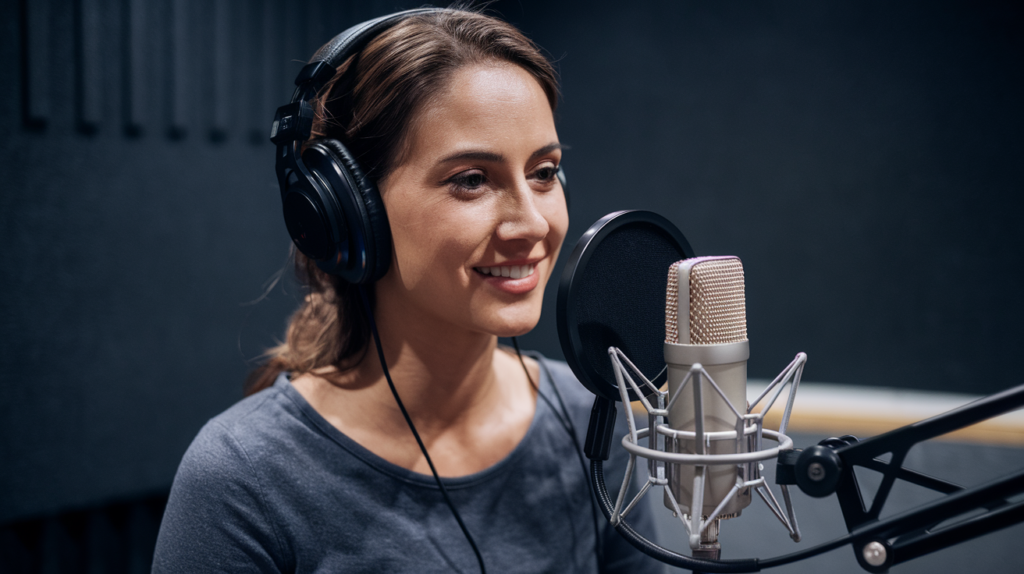Key Takeaways
- Regional Variations: Romanian pronunciation differs significantly across regions, influenced by local dialects and historical factors. Familiarizing yourself with these variations is crucial for effective communication.
- Vowel Sounds: Understanding the seven pure vowels and additional sounds like „ă” and „â” is essential, as their pronunciation can vary regionally, impacting clarity in speech.
- Consonant Clusters: Articulation of consonant clusters varies among speakers. Mastering these nuances enhances comprehension and reduces misunderstandings in conversation or voiceover work.
- Diphthongs & Intonation: Diphthongs such as „au” and „ei” add complexity to pronunciation; intonation patterns also differ regionally, affecting message perception.
- Stress Placement: Correct stress placement is vital for understanding word meanings in Romanian, as misplacing stress can lead to confusion during conversations or recordings.
- Common Challenges for Learners: Vowel sounds, consonant clusters, diphthongs, intonation patterns, and regional accents present challenges that learners must address to improve fluency and connection with native speakers.
Ever wondered why some Romanian words sound so different depending on the region? Pronunciation differences in Romanian can be tricky to navigate, especially if you’re trying to learn the language or connect with locals.
Overview Of Pronunciation Differences In Romanian
Romanian pronunciation varies significantly across regions, creating a rich tapestry of sounds. These variations often stem from historical influences and local dialects, making it essential for you to understand them if you’re engaging with native speakers or considering voiceover work in the language.
Key Pronunciation Features
- Vowel Sounds
[ɑ]Vowels in Romanian can differ greatly. For example, the letter „a” is pronounced as in some areas while sounding like elsewhere. Understanding these nuances helps ensure accurate communication.[a]
- Consonant Clusters
Consonant clusters may be pronounced differently based on regional accents. Some speakers articulate consonants more distinctly than others, affecting overall clarity.
- Diphthongs
Diphthongs play an important role in Romanian pronunciation. Certain regions blend vowel sounds smoothly, while others emphasize individual vowels more clearly.
- Intonation Patterns
Intonation patterns vary widely across Romania’s geographic landscape. You might notice that questions are raised differently depending on the region, impacting how messages are perceived.
- Stress Placement
Stress placement can change word meanings entirely in Romanian; incorrect stress can lead to misunderstandings during conversations or recordings.
By familiarizing yourself with these pronunciation differences, you’ll enhance your ability to connect authentically with native speakers and convey messages accurately—whether you’re preparing for voiceover projects or simply aiming to improve your communication skills in Romanian.
Key Characteristics Of Romanian Pronunciation
Romanian pronunciation features distinct characteristics that set it apart from other Romance languages. Understanding these nuances can significantly enhance your communication skills, especially if you’re engaging with native speakers or exploring opportunities in voiceover work.
Vowel Sounds
Romanian has a rich vowel system consisting of seven pure vowels: /a/, /e/, /i/, /o/, /u/, and two additional sounds represented by the letters „ă” and „â.” The vowel „ă” is pronounced as a schwa, similar to the ‘a’ in „sofa.” This sound often appears in unstressed syllables. The diphthongs, such as „au” and „ei,” add complexity to pronunciation. You’ll notice that regional accents influence how these vowels are articulated, contributing to the overall diversity of Romanian speech.
Consonant Sounds
Consonants in Romanian include a variety of distinctive clusters and sounds. For instance, the combination “ț” produces a sound akin to “ts,” while “ș” represents an English-like “sh.” Certain consonants change based on their position within words; for example, voiced consonants like „b,” „d,” and „g” may become unvoiced at word endings. Additionally, you might encounter palatalized consonants like “c” (pronounced as “ch”) before front vowels. These subtleties can affect clarity in voice acting roles or when delivering messages as a voice talent.
By mastering these key elements of Romanian pronunciation, you’ll improve your ability to connect with audiences effectively—whether through conversation or dynamic voiceovers.
Regional Variations In Pronunciation
Regional variations in Romanian pronunciation add unique flavors to the language, making it rich and diverse. Understanding these differences enhances your communication skills, especially if you’re considering work as a voice artist or voice actor.
Transylvanian Accent
The Transylvanian accent stands out with its distinctive intonation patterns and vowel pronunciations. Speakers often emphasize the vowels „ă” and „â,” giving words a melodic quality. You’ll notice that consonants can soften slightly, creating a smoother flow in speech. This accent’s unique characteristics can impact how you deliver lines as a voice talent, shaping your overall sound and style.
Moldovan Accent
In Moldova, pronunciation varies significantly from the standard Romanian spoken elsewhere. The Moldovan accent features nasal sounds that lend an earthy tone to speech. Vowel elongation occurs frequently, adding emphasis to certain syllables and altering rhythm. If you’re adapting your voice for this audience, recognizing these nuances will enhance authenticity in your delivery as a voiceover actor.
Wallachian Accent
Wallachian pronunciation is characterized by its clear articulation of consonant clusters and diphthongs like „au” and „ei.” Speakers may have a tendency to stress different syllables compared to other regions, affecting the overall cadence of their speech. For those pursuing work in voiceovers or seeking to connect with clients from this area, mastering the Wallachian accent will help convey messages more effectively and resonate with local audiences.
By paying attention to these regional accents, you can refine your skills as a voice actor or artist. Properly capturing these nuances not only fosters better communication but also elevates your performances across various platforms.
Common Pronunciation Challenges For Learners
Romanian pronunciation presents unique challenges that can trip up learners. You’ll encounter various elements that require attention for clear communication, especially if you’re aiming to connect with native speakers or pursue voiceover work.
- Vowel Sounds
Romanian boasts seven pure vowel sounds, along with additional ones like „ă” and „â.” These vowels might not exist in your native language, creating confusion. Practicing these distinct sounds helps improve both spoken clarity and overall fluency.
- Consonant Clusters
Consonant clusters in Romanian can be tricky. Combinations such as “str” or “ndr” may feel awkward at first. Focusing on articulating each consonant clearly aids in reducing misunderstandings during conversations or recordings.
- Diphthongs
Diphthongs like „au” and „ei” introduce complexity to pronunciation. They often change depending on regional accents, which adds another layer of difficulty for learners striving for accuracy in their speech patterns.
- Intonation Patterns
Intonation plays a crucial role in conveying meaning. In Romanian, the rise and fall of your voice can affect how messages are interpreted. Practicing with native speakers enhances your ability to master this aspect effectively.
- Stress Placement
Correct stress placement is vital for comprehension; misplacing stress can lead to confusion over word meanings. Engaging with audio materials from native speakers allows you to internalize the correct patterns naturally.
- Regional Variations
Different regions exhibit distinct pronunciation styles—Transylvanian accents sound melodic while Moldovan accents emphasize nasal qualities. Familiarizing yourself with various regional pronunciations bolsters your adaptability and connection when interacting with diverse audiences.
Understanding these common challenges helps you sharpen your skills as a learner and enhances communication effectiveness—essential traits for any aspiring voice actor or voice artist looking to make an impact through their work.
Conclusion
Mastering the pronunciation nuances in Romanian can significantly enhance your communication skills. By understanding regional differences and key features like vowel sounds and consonant clusters, you’ll be better equipped to engage with native speakers.
Whether you’re learning Romanian for travel or considering voiceover work, grasping these intricacies will help you connect more authentically with locals. Embrace the challenge of mastering these elements, as doing so not only enriches your language journey but also opens doors to deeper cultural connections. Keep practicing and you’ll find that your efforts pay off in meaningful ways.
Frequently Asked Questions
What are the main pronunciation features of Romanian?
The main pronunciation features of Romanian include its rich vowel system, which consists of seven pure vowels and additional sounds like „ă” and „â.” It also has unique consonant clusters, diphthongs such as „au” and „ei,” and distinct intonation patterns. These elements vary by region, influencing how words are articulated.
How do regional accents affect Romanian pronunciation?
Regional accents in Romanian, such as Transylvanian, Moldovan, and Wallachian, significantly influence pronunciation. For example, the Transylvanian accent is melodic with softer consonants, while the Moldovan accent includes nasal sounds and elongated vowels. These variations can alter rhythm and clarity in communication.
What challenges do language learners face with Romanian pronunciation?
Language learners often struggle with mastering vowel sounds, consonant clusters, diphthongs, intonation patterns, and stress placement in Romanian. Misplacing stress can lead to misunderstandings. Familiarizing themselves with these challenges is essential for effective communication with native speakers.
Why is it important to understand regional variations in Romanian?
Understanding regional variations in Romanian enhances communication skills for those engaging with local speakers or considering voiceover work. It allows learners to connect more authentically by adapting their speech to match local pronunciations and nuances.
How can mastering pronunciation improve voice acting in Romanian?
Mastering pronunciation helps voice actors deliver clearer performances that resonate better with local audiences. By understanding vowel sounds, consonant combinations, and regional accents, they can refine their articulation for a more authentic representation of characters or messages in their work.







